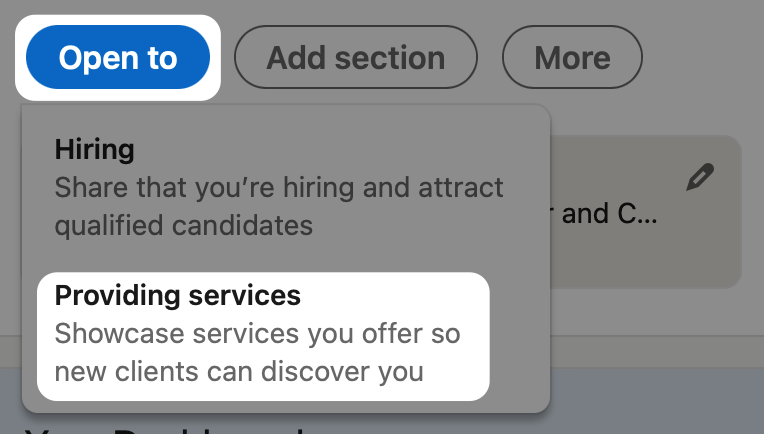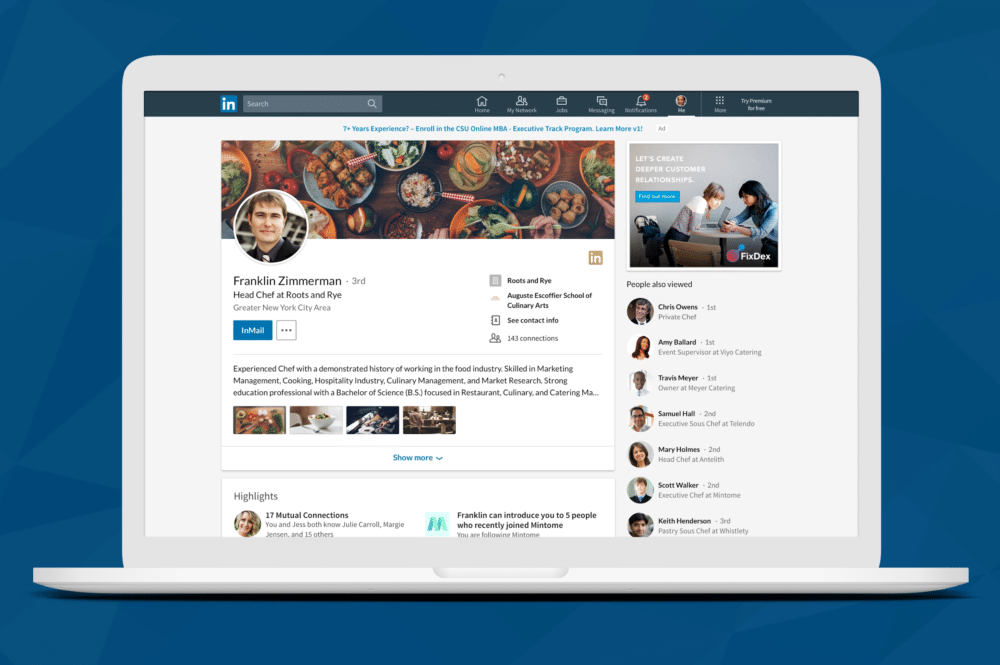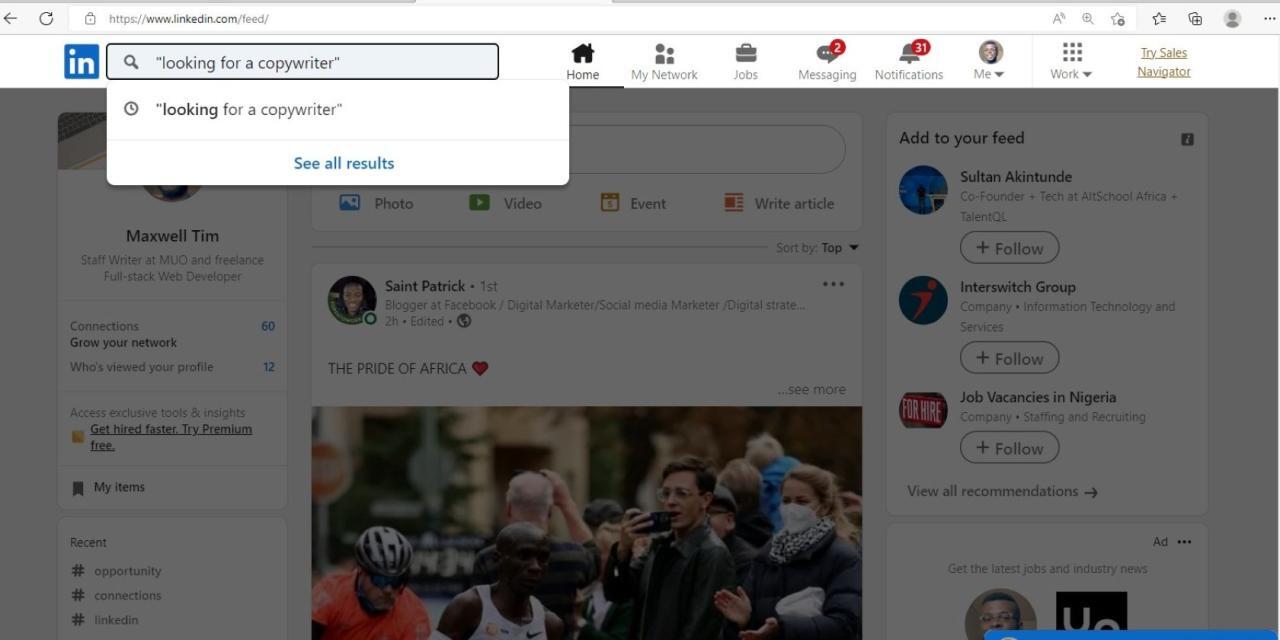Harnessing the power of LinkedIn to find lucrative freelance opportunities is a strategic move for today’s independent professionals. This guide provides a comprehensive roadmap, walking you through the intricacies of LinkedIn’s features, from optimizing your profile to effectively networking and securing high-paying gigs. By understanding the landscape and implementing the strategies Artikeld, you’ll be well-equipped to leverage LinkedIn’s vast network for freelance success.
The guide delves into several crucial aspects, including understanding LinkedIn’s freelance landscape, identifying high-demand niches, crafting a compelling profile, networking effectively, and utilizing LinkedIn for finding and applying to gigs. It also explores the vital steps for client acquisition and retention, offering actionable advice for building long-term professional relationships on the platform.
Understanding LinkedIn’s Freelance Landscape

LinkedIn has evolved into a powerful platform for freelancers to connect with potential clients and find high-paying gigs. Beyond simply networking, LinkedIn offers specific features designed to streamline the freelance job search and showcase your expertise. Understanding these features and optimizing your profile can significantly increase your chances of securing lucrative freelance opportunities.LinkedIn’s ecosystem is rich with opportunities for freelancers.
Utilizing its search functionalities, coupled with a well-crafted profile, allows freelancers to position themselves effectively for the highest-paying gigs. Strategic use of LinkedIn’s tools, combined with a strong online presence, is key to success in the freelance marketplace.
LinkedIn Features for Freelance Gigs
LinkedIn offers a suite of tools to aid freelancers in finding and showcasing their skills. These tools are crucial for reaching potential clients and effectively highlighting expertise. Direct messaging, group discussions, and specific job postings are all valuable channels for freelance opportunities.
- Job postings: LinkedIn’s job postings section is a valuable resource. Search for relevant freelance positions and apply directly through the platform. Active participation in these postings is key to standing out from other applicants. Be sure to tailor your application to the specific requirements of each job posting for maximum effectiveness.
- Networking: LinkedIn’s networking features enable freelancers to connect with potential clients and collaborators. Join relevant groups, engage in discussions, and build relationships. Building strong connections is paramount to finding high-paying gigs. This involves demonstrating expertise and a genuine interest in the needs of potential clients.
- Recommendations: Testimonials from satisfied clients are invaluable. Ask clients for recommendations to enhance your profile and showcase your expertise and experience. Recommendations provide social proof of your value as a freelancer, which is crucial for building trust and credibility.
Utilizing Search Filters for High-Paying Gigs
Strategic use of LinkedIn’s search filters allows freelancers to target specific, high-paying opportunities. Refining your search results with the right criteria is vital for success. This includes location, industry, job title, and even specific skills or experience levels.
- Targeting high-paying industries: Identify industries known for higher freelance compensation. Research the average rates for freelance work in those industries. High-demand industries often offer more lucrative opportunities for freelancers.
- Using advanced search filters: LinkedIn offers advanced search options that allow you to narrow your search based on specific s, job titles, locations, and experience levels. This refined search helps identify high-paying opportunities more effectively.
- Location-based targeting: If you have a preference for certain locations or are open to remote work, utilize location-based filters to narrow your search results. This will yield opportunities that align with your geographic preferences.
Crafting a Compelling LinkedIn Profile
A well-optimized LinkedIn profile is essential for freelancers seeking high-paying gigs. It serves as your online resume and professional brand. A well-structured profile clearly demonstrates your skills, experience, and value proposition.
| Profile Section | Optimization Strategies for Freelance Work |
|---|---|
| Summary | Clearly articulate your freelance services, target audience, and pricing structure. Highlight unique skills and experiences that set you apart. Use s relevant to your freelance niche to improve search engine visibility. |
| Experience | Showcase your freelance projects, highlighting the value you delivered. Quantify achievements and results whenever possible, using metrics and data to demonstrate impact. |
| Skills | Use s relevant to your freelance services to increase visibility. Ensure that the skills you list accurately reflect your capabilities and expertise. Include specific software, tools, or platforms you use in your freelance work. |
| Recommendations | Seek recommendations from past clients to build trust and credibility. Recommendations from satisfied clients add social proof and enhance your profile’s impact. |
| Portfolio | If possible, showcase your best work by including links to your portfolio website, GitHub repository, or other relevant platforms. A strong portfolio reinforces your claims of expertise. |
Identifying High-Paying Freelance Niches

Identifying high-paying freelance niches on LinkedIn requires a strategic approach that goes beyond simply searching for jobs. Understanding the specific skills and industries in high demand, along with the associated compensation ranges, is crucial for targeting lucrative opportunities. This involves researching various freelance roles, recognizing trends, and leveraging LinkedIn’s networking features to connect with professionals in these specialized fields.LinkedIn offers a wealth of data for analyzing freelance market trends and identifying high-paying niches.
By focusing on specific skills and industries, freelancers can increase their chances of securing well-compensated projects. This analysis enables the identification of promising opportunities, allowing freelancers to tailor their profiles and outreach strategies to target these specific niches effectively.
High-Demand Freelance Skills on LinkedIn
Several freelance skills are consistently in high demand on LinkedIn. These often intersect with evolving technological trends and the increasing need for specialized expertise in various sectors. The skills below demonstrate a clear trend of demand and potential for higher compensation.
- Data Analysis and Visualization: The need for professionals who can collect, analyze, and present data insights is increasing rapidly across diverse industries. This includes expertise in tools like Tableau, Power BI, and Python libraries for data manipulation.
- Digital Marketing & : Companies are continually seeking individuals who can develop and implement successful digital marketing strategies, particularly those focusing on and content marketing. This skillset includes knowledge of social media marketing, Google Ads, and other relevant platforms.
- Web Development (Front-End & Back-End): The demand for skilled web developers remains strong. Both front-end and back-end developers are in high demand, with a preference for those who are proficient in modern frameworks and technologies.
- Graphic Design & UI/UX Design: Businesses across various sectors require professionals who can create visually appealing and user-friendly designs. This includes expertise in graphic design, UI/UX design, and the use of relevant software.
- Technical Writing & Content Creation: Clear and concise communication of complex technical information is a valuable skill. This is often sought after by companies and organizations that need expert writers for documentation, articles, or other forms of technical content.
Comparing Pay Ranges for Freelance Roles on LinkedIn
Analyzing the compensation range for freelance roles on LinkedIn can be done through various methods. This involves identifying similar job postings, researching individual profiles of successful freelancers in the niche, and evaluating project-based compensation trends. A direct comparison of different job titles and skill sets can offer valuable insights into the compensation structure.
- Data Scientists: Compensation can vary significantly based on experience, specific skills, and the complexity of projects. However, data scientists frequently report higher earnings compared to other freelance roles, with experienced professionals often earning $50,000 to $150,000+ annually through project-based contracts.
- UX/UI Designers: Compensation depends on the designer’s portfolio, experience, and the specific requirements of the projects. Experienced designers can often command higher rates, sometimes exceeding $50-$75 per hour or more for complex projects.
- Specialists: The pay for specialists can vary depending on the level of expertise, the client’s budget, and the project scope. Experienced specialists with demonstrable results often command higher hourly rates, ranging from $50 to $150 or more per hour.
Strategies for Finding Niche Communities on LinkedIn
Leveraging LinkedIn’s advanced search functions is a key strategy for finding niche communities related to high-paying freelance work. Understanding the language used in these communities and actively participating in relevant discussions is crucial.
- Use s related to high-demand skills and industries. For example, instead of searching “freelance jobs,” try “freelance data scientist,” “freelance UX designer,” or “freelance specialist.” This helps target specific communities and refine your search results.
- Join relevant LinkedIn groups. Identifying and participating in groups focused on high-paying freelance work, such as those centered around specific technologies or industries, is beneficial. Active engagement in discussions and sharing your expertise can attract potential clients.
- Engage with industry leaders and influencers. Networking with influential figures in the target niche can provide valuable insights and connections, which could lead to high-paying projects or referrals.
Examples of LinkedIn Groups Focused on High-Paying Freelance Gigs
Several LinkedIn groups cater to specific high-paying freelance niches. These groups offer valuable networking opportunities and insights into the specific requirements and compensation structures within those fields.
- Data Science Professionals: Groups focusing on data science, machine learning, or specific data visualization tools.
- UX/UI Design Community: Groups dedicated to UX/UI design, design trends, or specific design software.
- & Digital Marketing Experts: Groups focusing on , digital marketing strategies, or specific marketing platforms.
Relationship Between Skills, Industries, and Potential Freelance Pay
The following table demonstrates the relationship between skills, industries, and potential freelance pay, highlighting the interconnectedness of these factors.
| Skill | Industry | Potential Freelance Pay (Approximate) |
|---|---|---|
| Data Analysis | Finance, Healthcare, E-commerce | $50,000 – $150,000+ per year |
| UX/UI Design | Technology, E-commerce, SaaS | $50 – $150+ per hour |
| Specialist | E-commerce, Marketing Agencies, SaaS | $50 – $150+ per hour |
| Technical Writer | Software, Technology, Engineering | $50 – $100+ per hour |
Crafting Compelling LinkedIn Profiles for Freelancers
A strong LinkedIn profile is crucial for freelancers seeking high-paying gigs. It’s your professional online storefront, showcasing your skills, experience, and value proposition. A well-crafted profile attracts potential clients and employers, increasing your visibility and opportunities. A compelling profile will not only enhance your discoverability but also demonstrate your professionalism and expertise.A compelling LinkedIn profile acts as a dynamic resume and portfolio, making it easier for potential clients to understand your value proposition and the services you offer.
It’s more than just a list of your accomplishments; it’s a story of your expertise, showcasing your passion and ability to deliver results.
Crafting a Compelling LinkedIn Headline
A compelling headline is the first impression on LinkedIn. It should be concise, descriptive, and accurately reflect your freelance services and target market. Avoid generic titles and instead highlight your specific expertise and niche. For example, instead of “Freelancer,” consider “UX/UI Designer | Web Application Developer | Freelancer.” This headline clearly communicates your expertise and services, making it easier for potential clients to find you.
Writing a Professional LinkedIn Summary
The LinkedIn summary is your opportunity to tell your story. This section should go beyond a simple list of your skills and experiences. It should paint a picture of who you are, what you offer, and what sets you apart. It’s a brief narrative that should entice potential clients to learn more about your services. For example, a compelling summary for a freelance writer could be: “Passionate and results-oriented freelance writer with 5+ years of experience crafting engaging content for diverse industries.
Proven ability to develop compelling narratives that drive results and achieve client goals.”
Showcasing Relevant Skills and Experience
Demonstrating relevant skills and experience is vital for a freelance profile. Your profile should highlight the skills most in demand within your niche. Use s that potential clients would search for, such as “,” “content marketing,” or “web design.” Ensure that your experience section clearly articulates your accomplishments and quantifiable results.
Optimizing the “Experience” Section
The “Experience” section is where you showcase your professional history. For freelancers, this is where you demonstrate your value proposition and track record. Use action verbs to describe your responsibilities and achievements, quantifying your results whenever possible. For example, instead of “Managed social media accounts,” write “Increased social media engagement by 25% through strategic content creation and community management.” Use relevant s in your descriptions.
Strong LinkedIn Recommendations
Recommendations from satisfied clients are highly valuable. They add social proof to your profile, demonstrating your expertise and trustworthiness. Encourage clients to leave recommendations for you, focusing on specific accomplishments and the value you provided. Examples include: “Highly recommend [Freelancer Name] for their exceptional writing skills and attention to detail. They consistently delivered high-quality content on time and within budget.”
Key Components of a Strong Freelancer Profile
| Key Component | Benefit |
|---|---|
| Compelling Headline | Immediately conveys expertise and services. |
| Professional Summary | Attracts potential clients with a compelling narrative. |
| Relevant Skills | Matches profile with client searches. |
| Quantifiable Experience | Demonstrates value and impact. |
| Strong Recommendations | Builds trust and credibility. |
Networking Effectively on LinkedIn for Freelance Opportunities

Building a strong professional network on LinkedIn is crucial for finding high-paying freelance gigs. Effective networking involves strategic connection building, personalized communication, and active participation in relevant communities. This approach allows you to connect with potential clients and recruiters, showcasing your expertise and opening doors to lucrative freelance opportunities.Effective networking strategies are not just about quantity but quality.
Focusing on building genuine relationships with potential clients and recruiters leads to more fruitful collaborations and sustained opportunities. By tailoring your approach and demonstrating genuine interest, you can increase your chances of landing high-paying freelance work.
Connecting with Potential Clients and Recruiters
Connecting with the right people on LinkedIn is a key component of finding freelance work. This involves understanding who to connect with and crafting compelling connection requests that stand out from the crowd. Target your connections based on your niche, seeking potential clients or recruiters in your industry.
Sending Personalized Connection Requests
A generic connection request is often ignored. Crafting a personalized message that highlights your value proposition and aligns with the recipient’s interests is vital. Demonstrating a genuine interest in their work and offering specific value is crucial.
- Example 1 (for a potential client): “I came across your work on [project/article/company], and I’m particularly impressed with [specific detail]. My freelance expertise in [your skill] aligns well with your needs, and I’d love to discuss how I can help you achieve [specific result].”
- Example 2 (for a recruiter): “I’m a highly motivated freelancer with [number] years of experience in [your field]. I’ve been following [recruiter’s company] and admire your work in [specific area]. I’m looking for freelance opportunities and believe my skills in [your skills] would be a valuable asset to your team.”
Participating in LinkedIn Groups
Engaging in relevant LinkedIn groups allows you to connect with professionals in your niche and build credibility. Active participation, sharing valuable insights, and asking thoughtful questions position you as a knowledgeable expert.
Leveraging LinkedIn’s Messaging System
LinkedIn’s messaging system is a powerful tool for nurturing relationships and pursuing freelance opportunities. Sending timely and relevant messages demonstrates your engagement and interest. Nurturing these relationships through follow-up messages, sharing helpful content, and demonstrating continued value are important for sustained engagement.
Strategies for Different Networking Activities
| Networking Strategy | Description | Effectiveness |
|---|---|---|
| Connecting with potential clients | Identify and connect with individuals whose work aligns with your expertise. | High. Targeted connections are more likely to lead to opportunities. |
| Connecting with recruiters | Identify recruiters in your industry and connect with them. | High. Recruiters often have insight into potential freelance projects. |
| Participating in relevant groups | Engage in discussions, share valuable insights, and participate actively. | Medium. Builds your reputation and allows you to engage with a broader audience. |
| Nurturing relationships via messaging | Follow up with connections, share relevant content, and proactively engage. | High. Demonstrates continued interest and value, fostering stronger relationships. |
Utilizing LinkedIn for Finding and Applying to Freelance Gigs
LinkedIn provides a powerful platform for freelancers to not only showcase their expertise but also actively seek out and secure high-paying freelance opportunities. By understanding how to leverage LinkedIn’s features and engage with the platform effectively, freelancers can significantly increase their chances of landing lucrative gigs.Leveraging LinkedIn’s diverse features allows freelancers to connect with potential clients and recruiters. Strategic posting, targeted networking, and a well-crafted application process are key components of this strategy.
This section delves into the practical aspects of finding and applying for freelance work on LinkedIn.
Discovering Freelance Opportunities on LinkedIn
Various avenues on LinkedIn can uncover freelance gigs. Active participation in relevant industry groups, monitoring company pages, and utilizing LinkedIn’s search functionalities are all crucial. Engaging with industry conversations and thought leadership content can also unveil potential opportunities.
Examples of LinkedIn Posts Showcasing Freelance Gigs
Several types of posts can effectively showcase freelance gigs. For instance, a post detailing a recent project, highlighting expertise, and seeking new opportunities. A freelancer might share a case study of a project, emphasizing results, and stating their availability for similar engagements. Another approach involves posting a targeted message within a specific industry group.
Tailoring Applications to Specific Freelance Gigs
Tailoring your application is paramount for success. Analyzing the specific requirements and showcasing how your skills align with the job description is essential. Highlighting past relevant projects and quantifiable results is a powerful way to demonstrate value. Clearly articulating your expertise and availability is also key.
Responding to LinkedIn Recruiter Messages and Soliciting Freelance Work
Recruiters often reach out to potential freelancers. Professionals should craft thoughtful responses that emphasize their expertise and experience, showcasing their alignment with the recruiter’s needs. Taking the initiative to proactively reach out to companies or individuals seeking freelance help can be very beneficial.
Best Practices for Applying to Freelance Jobs Posted on LinkedIn
Thorough preparation and attention to detail are vital. Reviewing the job description meticulously to understand the required skills and experience is crucial. Presenting a compelling profile, highlighting relevant experience, and providing tailored cover letters or introductory messages are key elements. Delivering a professional and polished application increases the chances of securing the job.
Table: Methods for Finding Freelance Gigs
| Method | Pros | Cons |
|---|---|---|
| Targeted Group Participation | High relevance to your field, potential for direct connections. | Requires active engagement and can be time-consuming. |
| Company Page Monitoring | Direct insights into company needs, potential for specialized roles. | May not yield many freelance opportunities unless proactively engaged. |
| LinkedIn Search | Efficient for identifying relevant gigs based on s. | Requires careful filtering and refinement to find suitable opportunities. |
| Industry Events and Networking | Opportunities to meet potential clients and recruiters in person. | Requires travel and networking skills. |
| Direct Outreach | Proactive approach, can lead to bespoke opportunities. | Requires careful targeting and personalized messaging. |
Leveraging LinkedIn for Client Acquisition and Retention
Building lasting client relationships is crucial for freelance success. LinkedIn provides a powerful platform to not only attract new clients but also cultivate strong, long-term partnerships. Effective use of LinkedIn can transform casual connections into valuable client relationships.Demonstrating expertise, showcasing successful projects, and fostering open communication are key strategies for client acquisition and retention on LinkedIn. This involves proactive engagement, building trust, and consistently providing value to potential and existing clients.
Showcasing Past Successful Projects and Testimonials
A compelling portfolio of past projects is essential to demonstrate your capabilities and expertise. Include detailed descriptions of your work, highlighting your accomplishments and the positive outcomes for clients. Quantifiable results, such as increased sales or improved efficiency, will strengthen your credibility. Showcase visual elements like before-and-after images, project timelines, and client testimonials.
Building Trust and Credibility with Clients on LinkedIn
Establishing trust is paramount in client relationships. Actively participate in relevant industry discussions, share insightful articles, and offer helpful advice to potential clients. Highlighting your expertise through well-crafted posts, thoughtful comments, and responses to inquiries builds credibility and showcases your knowledge. Consistency in these actions is vital to fostering a perception of reliability and competence.
Utilizing LinkedIn to Maintain Ongoing Communication with Clients
Regular communication is key to nurturing relationships. Send personalized messages to follow up on projects, share relevant industry updates, or offer assistance. This demonstrates your commitment to clients and keeps you top-of-mind. This proactive approach builds a strong foundation for future collaborations.
Requesting Testimonials and Case Studies to Improve Your Profile
Positive testimonials are powerful social proof that enhances your credibility. Actively request testimonials from satisfied clients. These testimonials can be incorporated into your LinkedIn profile or used in targeted outreach. Similarly, case studies offer in-depth examples of your work and its impact on clients.
Utilizing LinkedIn to Establish Long-Term Relationships with Clients
LinkedIn facilitates the development of long-term client relationships. Treat every interaction as an opportunity to learn about your client’s needs and offer support beyond the scope of immediate projects. Nurturing these relationships through ongoing communication and proactive engagement is vital to long-term success.
Methods for Acquiring and Retaining Clients Using LinkedIn
This table illustrates various strategies to acquire and retain clients using LinkedIn:
| Method | Description | Example |
|---|---|---|
| Showcase Successful Projects | Detail past projects, highlighting accomplishments and quantifiable results. | “Increased website traffic by 25% through optimization for Client X.” |
| Build Trust & Credibility | Engage in industry discussions, share valuable content, and respond to inquiries promptly. | Actively commenting on relevant posts and sharing insightful articles. |
| Maintain Ongoing Communication | Follow up on projects, share relevant industry updates, and offer assistance. | Sending a personalized message after a project concludes, sharing a relevant article. |
| Request Testimonials | Actively seek feedback from satisfied clients for use in your profile or outreach. | “Would you be open to sharing a brief testimonial about your experience working with me?” |
| Establish Long-Term Relationships | Nurture connections beyond immediate projects, offering support and proactive engagement. | Offer advice or resources to clients outside the scope of their project. |
Closing Notes

In conclusion, this guide equips freelancers with the tools and knowledge necessary to effectively use LinkedIn for securing high-paying freelance opportunities. By mastering the strategies presented, you can navigate LinkedIn’s ecosystem, build a strong online presence, and ultimately achieve your freelance aspirations. The key takeaways underscore the importance of a well-optimized profile, targeted networking, and a proactive approach to finding and securing freelance work on LinkedIn.